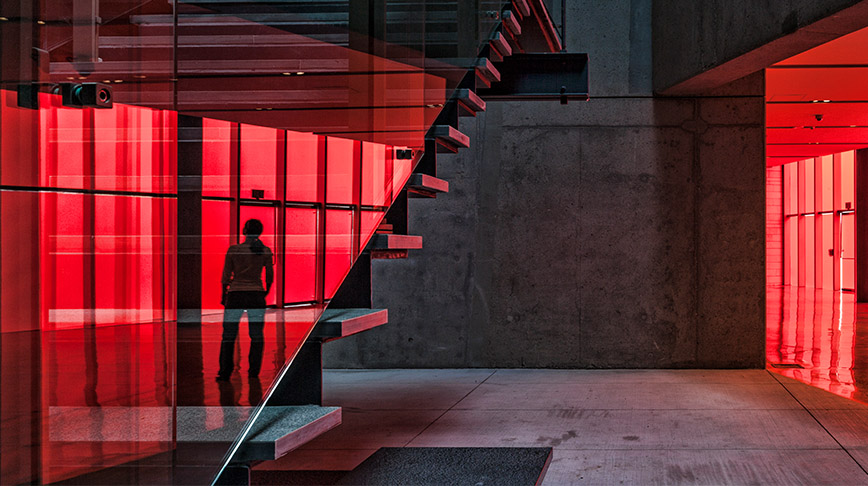MSc Architectural Lighting Design
Light is essential for human well-being and fundamental to the built environment in its different scales: interior spaces, buildings and urban areas. You will explore how natural and artificial lighting quality affects human behaviour, comfort and health. Factors of sustainable development; environmental, social and economic aspects are at focus. Graduates have unique competence in light planning and work in lighting design, architectural studios or as consultants.

Architectural Lighting Design at KTH
The master's programme in Architectural Lighting design takes on a new approach to light and light planning – a combination of visual, physical and biological-based experience and knowledge applied to design, technology and health. It provides an in-depth understanding of the field through scientific-based expertise and practical experience in artificial light and daylight. Graduates from the programme can apply advanced knowledge in lighting design in both practical and academic situations.
The programme uses innovative teaching and learning methods such as structured lectures and peer-review practices. Interactive sessions create a constructive learning environment in which understanding of the subject is developed through the interaction of students and teachers via presentations and open discussions, tutoring and workshops. The education mixes theory and practice, where you will perform full-scale studies via prototypes and mock-ups to trigger first-hand experience of light within architecture. Furthermore, laboratory sessions allow an in-depth understanding of physical and visual phenomena. We offer a series of motivational lectures throughout the programme, where acclaimed international and national lighting designers, architects and researchers share their knowledge and expertise. Your advancement is assessed through a combination of individual and group work assignments.
The programme is developed by the Lighting Design Laboratory, a division of the Department of Architecture at the School of Architecture and the Built Environment at KTH. The Lighting Laboratory carries out several research projects with companies and other institutions where students are involved.. The division also organises events to interface the academy with companies and research institutions on specific topics, such as the annual Light Week, a collaboration with Swedish Energy Agency. Since 2010 KTH has organised the Light Symposium, a two-day international event focused on light and health, with the universities of Wismar, Aalborg and South-Eastern Norway as partners. KTH has hosted this event on 2010, 2015, 2018 and recentrly on Fall 2023. will host this event in the fall of 2023.
The programme consists of four regular courses and a master's degree project that you will conduct at the end of the second semester.
This is a full-time one-year programme (60 ECTS credits) given in English. Graduates are awarded the degree of Master of Science. The programme is given mainly at KTH Campus in Stockholm by the School of Architecture and Built Environment (at KTH) with a series of study visits and workshops in Stockholm.
Light and Humans
The programme begins with the course in Light and Humans, where students explore the relationship between light and humans, which is mediated by physical space. Knowledge related to light qualities, cultural and human aspects, light sources and materials is combined with the experience of the design process. After the course, you can develop a complete solution for a lighting design proposal, following the design method developed at the division.
Light and Space – outdoor
Following Light and Humans you will take the course Light and Space – outdoor. The course focuses on the relationship between light and outdoor environments, especially urban contexts and its physical and cultural characteristics. The course will expand your knowledge of the methodology and tools of the outdoor lighting processes, concepts and vocabulary. The design tasks concludes with full-scale hands on lighting installations, preparing you to deal with challenges such as ecological impact, social interactions and urban identity.
Light and Science
The final course of the first semester is Light and Science, where your theoretical knowledge about light and its relationship to space and humans is further developed through discussions between fellow students and researchers in the field, lectures, experimental sessions and study visits. You will gain the ability to analyse methodologically lighting conditions through understanding the visual and physical concepts of light by conducting a practical case study with a photometric and ethnographic approach that you will present as an academic paper.
Light and Space – indoor
In this course you will learn the importance of dealing with daylight in combination with artificial lighting in indoor spaces through activities related to sources of light and technology, spatial theory and visual ergonomics, performance and sustainability. In the course, you will also enhance your skills in the design process, planning, calculations and presentation techniques through different tasks based on real case scenario projects.
Degree project
The programme is concluded with a degree project, the focus of which may be chosen from a wide variety of topics within the field of architectural lighting design. Theoretical papers with a strong focus on sustainability about light and health, light and time, urban lighting, perception and information, as well as practical projects with a theoretical frame in rural lighting and interactive lighting design, are a few examples of previous degree projects. Students from the master's programme in Architectural Lighting Design have consistently been granted national and international research funding and scholarships for developing their degree project.
Students
Find out what students from the programme think about their time at KTH.

Career
Lighting is an expanding field of knowledge. In recent years there has been a growing demand for lighting design expertise, as lighting designers understand the role of light and lighting in architecture, interior spaces and urban environments. They can add substantial value to a project by enhancing visual performance, energy efficiency, sustainability, safety, well-being and health. There are plentiful job opportunities for architects, designers and engineers with lighting design competence.
Graduates primarily work in lighting design or architectural studios or as self-employed consultants. Employers might also be construction companies, lighting manufacturers and public or private operators. Students graduating from the master's programme in Architectural Lighting Design have also pursued doctoral studies (PhD studies) at KTH or in other national or international universities.

Sustainable development
Graduates from KTH have the knowledge and tools for moving society in a more sustainable direction, as sustainable development is an integral part of all programmes. Architectural Lighting Design has an impact on each one of the aspects of the holistic concept of sustainability. It affects productivity, sociability, safety, orientation and health, while also being one of the significant sources of energy consumption. Evidence from research and practice indicates that design concepts based on an in‑depth knowledge of the context, the users and the technology provide solutions that are economically viable and healthy. The challenge for the future development of societies is addressed by sustainable lighting, in other words, lighting that meets visual and biological needs while having only a meagre environmental impact. This challenge relates to indoor and outdoor solutions and often involves off-grid solutions, which stimulate new thinking in terms of production, conservation and energy use.
The three key sustainable development goals addressed by the master's programme in Architectural Lighting Design are:



Sustainable development is pursued through various actions throughout the course, with a focus on Social, Cultural, Economic and Environmental aspects of Sustainability:
- The ability to identify and quantify the impact of Architectural Lighting Design projects within the different areas of sustainable development.
- Showing professional and ethical responsibility in their decisions as students and future Lighting Designers within the scientific and technical aspects of design.
- Ensuring sustainable development by applying an ethical and responsible approach to the social, ecological and economical aspects of their scope of work.
- Theoretical and experience-based understanding of the social impact of urban lighting projects.
- Planning and working throughout collaborative processes.
- Light and its influence on health.
- Analysis of energy consumption and basic control system strategies.
- Human-centred lighting approach.
- Economical aspects of a lighting installation.






